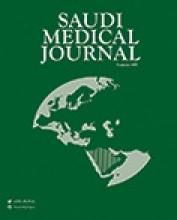Abstract
OBJECTIVE: To investigate the possible role of radiate ligament in idiopathic scoliosis.
METHODS: This study was designed as a case-control study adapted to cadavers. Eighteen human cadavers, 12 males and 6 females of Caucasian race, with a mean age of 55 years were studied at the Department of Anatomy, College of Medicine, King Saud University, Riyadh, Kingdom of Saudi Arabia from November 2010 to February 2012. Among the studied subjects, 15 were with normal spines, and 3 were scoliotic. The upper and lower bands of radiate ligaments were identified and measured. All cadavers were examined grossly. Scoliotic cadavers were also examined radiologically.
RESULTS: The present study revealed that the mean of the lengths of the upper bands of radiate ligaments, on the concave side, in each scoliotic cadaver showed a highly significant shortening compared with that of the upper bands of the corresponding segments in cadavers with normal spines, while no significant change was detected when comparing those of the lower bands to normal values.
CONCLUSION: The study suggested a possible relationship between radiate ligament shortening and the etiology of idiopathic scoliosis.
- Copyright: © Saudi Medical Journal
This is an open-access article distributed under the terms of the Creative Commons Attribution-Noncommercial License (CC BY-NC), which permits unrestricted use, distribution, and reproduction in any medium, provided the original work is properly cited.






